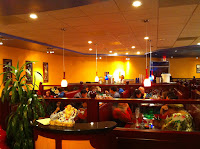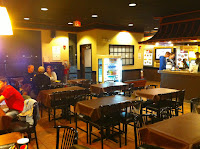But then, tragedy struck. Crazy Buffet became a victim of its own success. What was once the well guarded secret of Orlando’s semi upper crust soon leaked its way down the socioeconomic spectrum. Pressed shirts gave way to shorts, t-shirts, and flip flops. Couples and adult gatherings gave way to hordes of children running through the buffet area. It was like that episode of The Facts of Life, where Jo opens a pizza business and eventually had to start cutting corners as her orders escalated. Demand exceeded production capabilities, and management started making cutbacks to keep the tables turning over regularly. The crazy wok (their name for the Mongolian barbeque) vanished. One of the three sushi stations was mothballed. The Chinese food selection was simplified, and the duck station found itself relegated to weekends only. Eventually, Crazy Buffet became an ordinary Chinese buffet with a sushi line. Sadly, in researching this entry, I learned that Crazy Buffet closed in August--either a victim of the economy or health inspectors, depending on the site.
My biggest regret about my move to Raleigh was the lack of an all you can eat sushi place. Don’t judge me, we’ve talked about my relationship with sushi before here. Until last week, the best I had found were some places with moderate to decent BOGO specials. Then, when talking to friends at a holiday party, one of them mentioned a new Chinese buffet in Cary with a sushi bar.
I was skeptical. I’d had Chinese buffet sushi before. In Orlando, several Chinese buffets boasted “SUSHI!” on their marquees. It was like asking Santa Claus for a Generation 1 Optimus Prime or Megatron (you remember, the one that transformed into a gun, before he was Brady-Bill-ified into a tank, truck, or whatever vehicle was available) and instead getting a box of Go-bots under the tree. And not even the good Go-bots from the TV show, like Leader-1, Turbo, Cy-kill, or Cop-turr. We’re talking the D-list of Go-bots here: Scooter. All you could do was begrudgingly take the offering while nursing a quiet inner loathing as you braced for the first school day after the holiday, when your friends returned with Cybertron’s finest…while you had the store brand equivalent of transforming robots. Yeah, the sushi on those buffets was always that disappointing. Save for one place near NCSU that only offers a very limited sushi spread on a lunch buffet, I’ve never had good sushi at a Chinese buffet. But, as I’ve said in the past, a fix is a fix.
I pulled into Hibachi China Buffet in Cary with my roommate, promising myself that I wouldn’t allow myself to get my hopes up at the thought of sushi. If I pulled a Go-bot, I pulled a Go-bot. It was almost like a clichéd scene from a movie. Through the framed glass doors, I saw crowds congregating in front of the maitre’d, obscuring my view. As I opened the doors and stepped through, the crowds parted and revealed the buffet in all its glory. I felt myself falling in love all over again.
It was like stepping into Crazy Buffet, circa 2001, all over again. All that was missing was the pretentious waterfall, the lacquered driftwood bar tables, and a piano player laboring his way through “My Heart Will Go On” for the third time that night, in hopes of perhaps fishing a tip from one of the couples waiting for a table. My Sotalol-restrained heart almost skipped a beat.
When I eat at ethnic restaurants, I like to apply what I call the “minority test” as a means of preliminarily gauging the quality of the food—minority not because of the people eating there, but because as someone who’s as non-ethnic as you can get (a fat white guy of mostly Scottish stock, with a splash of Irish), if I’m made the minority by virtue of the presence of native diners, then that says something about the quality of the food. I’ve been to many Asian buffets where the only Asian people were working there, while the diners looked like they'd just stepped out of an Old Navy commercial. The night I visited, I saw a very heavy distribution of Korean, Japanese, and Chinese families there (including a large group in the back room), so my hopes already started raising as we were led to a booth.
 |
| No "you'll shoot your eye out" here |
 |
| "Think he'd roll me some eel, cream cheese, masago, and scallion?" |
“If you have any special requests for sushi, please let me know.”
 |
| Special orders don't upset them... |
So of course, the sushi bar was my first stop. The nigiri is pretty standard fare, with things like shrimp, tuna, salmon, crab (or “Krab” for purists) stick, and similar offerings. The rolls seem to be left to the chef’s discretion. If you’re adept at deciphering the cross-section of rolls, it can be a fun little adventure in interpreting a chef’s creativity. For example, fried sweet potatoes were in one of the rolls I picked up. It’s random…in a good way. Also worth noting: China Hibachi solves the dilemma of the Philly roll by making both variants—the salmon-cream cheese and the crab stick-cream cheese. The actual amount of rice on the rolls was a bit sparce. Maybe I’m just used to a thicker layer of rice on the rolls, or maybe the chefs were just hurried in a dinner rush, I’m not sure. In spite of the waifish appearance of my rolls, the sushi hit its mark for taste—the fish was fresh and the rice was neither over nor under seasoned. I’m working on a wish list of things to see if the chefs will make for me next time as I write this.
My next stop was the noodle station. China Hibachi offers four types of noodles served with a variety of broths, meats, and vegetables. I do have to admit that my impaired hearing (thanks mostly to an adolescence and twenties surgically attached to a personal stereo) made it a bit difficult to hear the chef, so I ended up doing some pointing and gesturing in between rounds of “what?” but I wound up with a bowl of shrimp udon after a few minutes. The udon was thick and perfectly firm—neither mushy now chewy. The broth had a nice spicy heat to it that stayed in my mouth for a few minutes after.
The hibachi station was more of the offspring of a hibachi grill and Mongolian barbeque—with a selection of meats, vegetables, starches, and sauces that are put into a bowl and handed off to a chef for cooking. The hibachi chicken plate I assembled was okay, but it was nothing spectacular.
The hot station offers up a variety of Chinese, Japanese, and Korean dishes. Because I was close to full, I sampled a few stand-bys, to gauge them against other places. The coconut shrimp was sweet and well cooked, neither drowned in sauce nor soggy. The sesame chicken was some of the best I’ve had in ages—with large, meaty chunks of meat in a tangy sauce. Usually, the meat in dishes like orange, sesame, or General Tso’s chicken is too heavily fried when I have them on a buffet, some places almost fried to dryness. The sesame chicken at China Hibachi was perfectly cut and prepared. Finally, the seafood delight (shrimp and crab stick with vegetables, in a brown sauce) was on par with what I’ve had in the past—passable, but there was nothing that made it stand out.
On one of the hot stations sat the added bonus for the weekend—dim sum. There were eight bamboo steamers, each with a small card in front of it. Some of the dishes were familiar, like shumai dumplings, shrimp dumplings, shrimp rice (served in leaf wrapper), while others were a bit more exotic. For example, when I saw the steamer marked “Phoenix Claws,” I obviously wasn’t expecting parts from a mythological critter, but I also wasn’t expecting chicken feet.
The desserts were standard fare—eight flavors of hard serve ice cream with the almost ubiquitous assortment of pastries: the same cream puffs, Napoleon, cream cakes, and other pastries I’ve mentioned in the past.
I’m not hiding my bias here. China Hibachi is a restaurant I’ll go to for the sushi and consider the rest of the buffet as either filler or bait to convince my sushi-phobic friends to join me. The sushi is freshly prepared and tastes amazing. The hot food has highs and lows, but no low enough to make me reconsider it. The desserts, tragically, are the same desserts that I’ve seen at cheaper buffets. I think I'm just going to start calling them "Chinese Mafia" desserts, in honor of my former roommate. Honestly, I’d love to know where the distributor of these desserts come from. I’ve seen them from Florida to Michigan. The restaurant has promise and potential. The fact that it was packed the night I visited it suggests that it’s got a prosperous future ahead of it. However, I’m reminded about the cautionary tale of Crazy Buffet, which used a near identical model to build a successful business on…then proceeded to cut corners and quality until it was a shadow of its former self and eventually collapsed under its own success. China Hibachi has established a solid mark of quality for buffets in Cary, and I’m hoping that they strive to keep it high in the months and years to come.











































